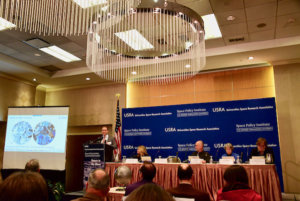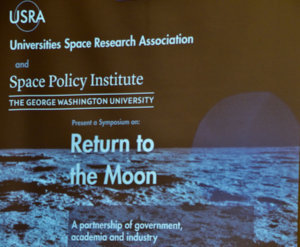31.03.2018
This December will mark the 50th anniversary of Apollo 8, which was the first crewed mission to the moon. Apollo 8 did not land but orbited the moon and safely returned to the Earth. Now, it seems Earth’s exploration of the moon looks poised to continue and expand.
At least that was the impression from the “Return to the Moon — A Partnership of Government, Academia and Industry” symposium Wednesday, sponsored by the Universities Space Research Association and George Washington University’s Space Policy Institute. The event featured a “who’s who” in lunar science and exploration from these groups.
Last December, the Trump administration issued Space Policy Directive 1, “a change in national space policy that provides for a U.S.-led, integrated program with private sector partners for a human return to the Moon, followed by missions to Mars and beyond,” according to a NASA statement.
Robert Lightfoot, NASA’s acting administrator, told the audience Wednesday, “NASA’s plan to return to the moon has been submitted to the administration and Congress, which has authorized money to do so in FY-19.”
“Space has become an arm of foreign policy and entails lots of international cooperation. NASA looks to engage academia and industry in this effort,” he added.
He also said, “NASA is a spotlight for inspiration and leadership, which is so important. NASA is not giving up on Mars, and the International Space Station is major to our efforts. We need to practice — are our systems ready? We can learn from the moon because it is so much easier to do so, and keep our eye on Mars.”

Lightfoot discussed what will be the centerpiece of NASA and its partners in going to the moon and Mars: the Lunar Orbital Platform-Gateway. The Gateway, as it is called, is expected to be in lunar orbit in the 2020s. It will be far smaller than the ISS and will not be crewed full-time; it is expected that robotic operation for research and upkeep will supplement crew visits.
“The Gateway allows us to come and go to Mars (as well as the lunar surface) and, with our international partners, build an overall architecture that allows us to do a lot of things with it,” Lightfoot said.
Other lunar luminaries provided remarks on returning to the moon, including Dr. Harrison Schmitt, Apollo 17 Lunar Module Pilot and the 12th human to walk on the moon. His fellow moonwalker, the late Capt. Gene Cernan, USN, was the last human (to date) to walk on the moon in December 1972.
Schmitt spoke about Space Policy Directive 1, since he was there in the White House for the signing of the directive. “It is geopolitically imperative for the free world and the U.S.,” he said.
I asked him if China was the “geopolitically imperative” he was referring to, and he replied, “China is what I refer to. It is comparable to what we faced in the 1960s.”
The race to be first to the moon became a contest between the U.S. and the former Soviet Union during that time. It was a facet to the Cold War between the superpowers that carried significant propaganda, political and military implications.
China is a rising global economic and military power that also has ambitions in space that include the moon. It has flown taikonauts, or Chinese astronauts, into space, and its Tiangong-1 space station is in an uncontrolled de-orbit that is predicted to conclude sometime this weekend.
China successfully sent its Chang’e 3 lander and accompanying Yutu rover to the moon in 2013. It has even more ambitious lunar landing missions planned starting in 2018 that entail returning a sample to Earth and the first-ever lunar far-side landing. China is also designing crewed spacecraft and rockets capable of sending taikonauts to the moon.

Expert panel members, including Schmitt, described the science that can be accomplished and resources available on and off the moon in lunar orbit. The moon has many mineral resources; water chemically locked in its rocks and in frozen polar craters; abundant sunlight for Earth and moon power supply, plus an isotope of helium created by the sun and deposited over billions of years in the lunar regolith — the churned up surface of the Moon — that could power future nuclear fusion reactors.
A common theme in the symposium was its “Post Apollo — A New Moon,” which could lead to a new space-earth economy and, with the Gateway, a space refueling architecture for the first time in spaceflight history.
Commercial lunar landers are becoming a reality that NASA intends to buy for its missions. Lunar landers, both robotic and crew-capable, are envisioned with actual lunar robotic landers foreseen in the future.
NASA is preparing for a return to crewed flight using U.S. assets utilizing its Commercial Crew Program, which uses crewed spacecraft built by Boeing and Space X to service the ISS.
NASA’s backbone for getting crews to the moon, the asteroid belt and Mars is the Orion Spacecraft and Space Launch System, or SLS. The first uncrewed flight of Orion and SLS is “Exploration Mission-1,” a 25-day flight to lunar orbit and a bit beyond, scheduled for launch in the early 2020s.
Combine the Gateway, Orion and SLS, plus NASA’s partners from academia, industry and internationally, a “Return to the Moon” seems very probable. China is certainly focused on doing so, as well. It seems that humanity is poised to return to the moon — and stay, this time.
Quelle: wtop
